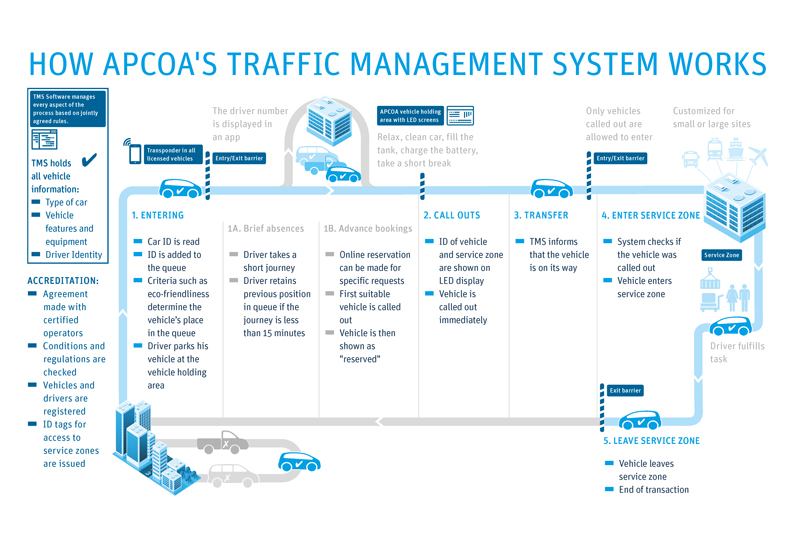Company Insight
Sponsored by APCOA Parking
The positive impact of the APCOA Traffic Management System at airports
Chaotic and congested service zones outside arrivals buildings benefit no-one. As this article explains, innovative traffic management systems, as adopted by Arlanda and Berlin Schönefeld airports, deliver an improved experience to passengers, a fairer allocation of rides to taxi drivers, higher revenues to airports and improved air quality
Caption
Traffic congestion is a constant and growing issue at most airports. When they leave, passengers want their onward journey to be seamless. However, often they are faced with chaotic scenes within the service zone in front of the arrivals building. They have to navigate through speeding traffic or badly parked vehicles to find a taxi. This creates unhappy passengers and a poor public image for the airport. It also leads to dissatisfaction amongst taxi drivers, and has an environmental impact, with emissions from idling engines polluting the air.
That means that taxi traffic management is an area that airports are increasingly focusing on, looking at how more intelligent systems can drive benefits for passengers, taxi drivers, operators and the environment. Two examples where innovation has driven success are Arlanda Airport in Stockholm and Berlin’s Schönefeld Airport. Both of these operators have experience working with APCOA PARKING’s Traffic Management System (TMS). The system manages every aspect of the taxi queuing and pick-up process.
It starts by controlling access to the service zone to registered taxis with ID tags. Without them vehicles simply can’t get entry. Registration means that airports can set specific standards for the type of vehicle they want to be entering the service zone. For example, they can take into account factors such as the environmental impact of a taxi when deciding who can be registered. This process also adds to security as only officially certified taxi drivers are allowed to operate.
Once through the first set of barriers, drivers are directed to a comfortable waiting area, where they can switch off their engines and get out of their vehicles. It also means that if they need to leave for a short time, such as for refuelling or cleaning their taxi, they can do this without losing their place in the queue.
The system has all relevant information about each vehicle, such as size, driver identity and any special features. This allows passenger requests to be easily matched. For example, if they want a large-capacity taxi or one that can transport pets, this can be quickly located and dispatched. Once called forward, taxis simply pick up their passengers from a clear, uncluttered service zone and transport them to their destination.

Image:
BENEFITING EVERYONE – AND THE ENVIRONMENT
The TMS provides multiple advantages to taxi drivers, passengers, the airport, and the wider environment.
Vitally, drivers can be sure that rides are allocated more fairly and they have the opportunity to wait in a clean, comfortable area. There are no additional costs to them, as these can be passed directly onto passengers. The system also removes the headache of the short trip fare. Taxi drivers returning from a short trip can register again within a defined time in the waiting area, putting them in a favourable waiting position, cutting out long delays before their next fare. When the system was first introduced at Berlin Schönefeld there was some scepticism from taxi drivers concerning the scheme, but this quickly changed when they saw the system in operation and realised the benefits. It promotes quality and helps optimise any waiting times they have between fares.
Passengers benefit because the system ensures that there are always enough taxis available – and that they can request one that fits their specific needs. The number of taxis allowed into the pick-up area is strictly controlled, which prevents congestion or confused conditions in front of the airport. Their onward journey is therefore smooth and seamless, helping the overall airport experience. As well as the positive reputational impact of TMS, airports also experience a safer service environment with less accidents and higher security.
Watch the video of an Elettric80 system equipped with Flash Battery lithium batteries

Image:
Emissions are reduced dramatically as taxis no longer sit in line outside the airport with their engines running; they have a special, designated area in which to wait for their next fare. This reduces CO2 emissions, but the system can do so much more. For example, at Arlanda a rewards scheme was introduced to promote environmentally friendly cars. As part of these electric vehicles receive better waiting positions. The result? After APCOA introduced its taxi management system at Arlanda in 2009, the proportion of environmentally friendly taxis rose from 16% to 84% within five years. In 2016, this has led to an additional reduction in CO2 emissions of approximately 16,000 tons on journeys made by taxis to and from Arlanda Airport.
As the examples of Arlanda and Berlin Schönefeld demonstrate, taking a new approach to traffic management can transform the service zone. Passengers have a much smoother, more pleasant experience, taxi drivers profit from a fair, transparent system, airport operators can reduce congestion, increase revenues and improve security, while we all benefit from reduced emissions and better air quality.
High-density seating makes more floor space available while providing up to 50% more seats. There’s more space for commercial traffic and far less congestion at gates.
Name, description
Contact details
APCOA PARKING Holdings GmbH
Frank van der Sant, Chief Commercial Officer
Flughafenstr. 34
70629 Stuttgart (Airport)
Germany
Tel: +49 711 94 791 - 738
Fax: +49 9181 896-1115
Email:airports@apcoa.eu
Website:www.apcoa.com
Caption